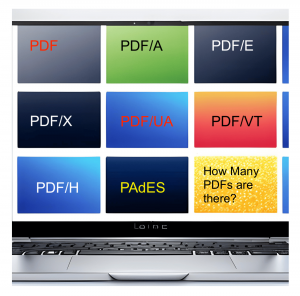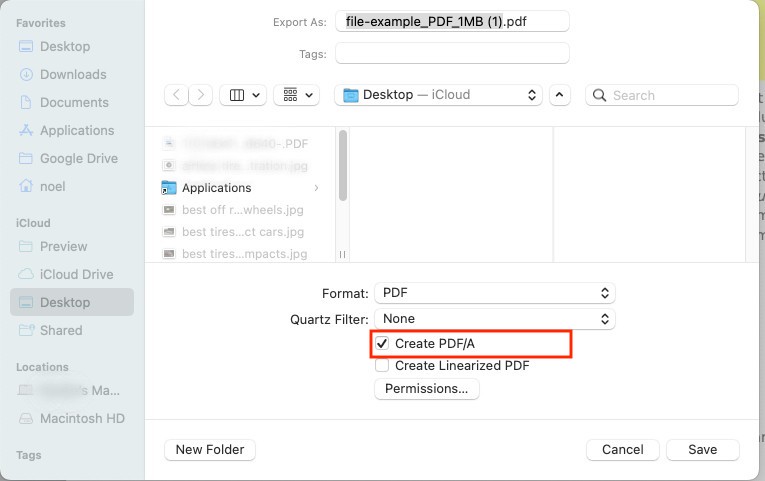Resources » PDF Basics »
Difference Between PDF and PDFA, PDFX and More
Did you know there are 8 different PDF formats? The various formats mean that the PDF will store information in slightly different ways. Each different type of PDF is intended for a different purpose and, sometimes, industry, which we’ll explain. Some PDF types you may never run into, while others you may commonly run into. It all depends on how you intend to use PDFs.
The PDF, or portable document format, is one of the most versatile document formats out there. Whether you open a PDF on a phone, Windows device, Mac, or any other type of device, it will always appear the same.
PDFs have become so popular thanks to the many devices and document editing software apps we use in the modern era. Some folks may prefer creating documents using Microsoft Word, while others use Google Docs, PowerPoint and other programs. Regardless, any document that you create with these programs will appear the same if it’s saved or exported as a PDF.
The 8 different PDF types are separated into two groups. The first group of 6 types are recognized by the International Standards Organization or ISO. This group is responsible for creating and recording international standards about best practices and procedures in a variety of industries. The other 2 types aren’t formally recognized by the ISO but nonetheless may be used by other organizations.
In this article, we’ll be going through all 8 types, what they’re used for and when you may encounter them.

ISO PDF Standards
1. PDF
The standard, most commonly used file developed for sharing and viewing documents across the web is .pdf. The PDF is versatile and easy to use. This will be the PDF type you’ll encounter the most often.
2. PDF/A
What is a PDFA? This file type is meant for long-term file storage. If you or your company deals with a large number of documents that need to be archived, the PDF/A has fewer restrictions for formatting settings (such as fonts or encryption). The goal is that any piece of software developed in the future will be able to use and view a PDF/A.
How do you create a PDF/A? When you open a PDF in your favorite PDF reader, many of them allow you to Export as or Save as and choose the PDF/A format. For example, in Apple Preview, select Export as, choose Format: PDF, and click the Create PDF/A option.

3. PDF/E
The PDFE (also PDF/E) was developed for engineers, architects, and construction experts. It’s meant to be used to share technical documents that include multimedia. It has features such as better integration with proprietary manufacturing/engineering software and lower storage costs on a system.
How do you create a PDF/E? Industry-specific software programs such as CAD programs have that ability built-in. If you need a PDF/E, chances are you are already using software programs that create PDF/E files.
4. PDF/X
If you’re working with high-quality graphics in documents with more specific color profiles, the PDFX (or PDF/X) is what you need. The PDF/X was developed for graphic designers and printing/creative professionals that need hyper-specific colors, image qualities, and fonts.
How do you convert PDF to PDF/X? Graphic design software programs, such as Adobe Illustrator for example, have this ability built-in.
5. PDF/UA
PDF/UA, or PDF/UniversalAccessibility, is a PDF type meant to be used by people with disabilities that require assistive technology like a screen reader. PDF/UA have a certain set of formatting settings required to be considered conforming with certain accessibility requirements. For example, graphics need to have text descriptions and the document needs to be navigable without a mouse/keyboard.
How do you create a PDF with universal accessibility? Many software programs have a feature called an accessibility checker. Some versions of Microsoft Word tuck Check Accessibility under the Tools menu (this may differ, depending on your computer operating system). In Google Docs, select Tools and Accessibility.
6. PDF/VT
The PDF/VT is very similar to the PDF/X format but is meant for variable and transactional printing. This means printing content like invoices, statements, or other financial information. It has the settings needed to create useful graphics/images but is geared toward marketing and finance, and the PDF/VT format is created by these types of programs.
Other Organization PDF Standards
Although not formally recognized by the ISO, there are two PDF file types that are still used in their respective industries/fields. These types are less common but show how the PDF can be developed for a specific industry’s needs.
7. PDF/H
The H in this file type stands for healthcare. It is a standard meant for handling, storing, and sharing sensitive healthcare information. This means that the standard was built with extra security and privacy features, intended to satisfy the provisions of the Healthcare Insurance Portability and Accountability Act (HIPAA).
8. PAdES
This most esoteric name for a PDF file type stands for PDF Advanced Electronic Signatures. It was developed for a very specific use case: To contain standards that comply with the European Union requirements for digital signatures. It’s meant to be used for government legislation and, most notably, the digital signature contained within is recognized with the same legal value as a handwritten signature!
Although there are a lot of other types and subtypes of PDFs you may encounter on the web, these 8 are the most commonly used. PDFs are continually being further developed with additional capabilities, extensions, and restrictions to be used in any industry. It’s entirely possible that physical documents may one day become entirely obsolete!

